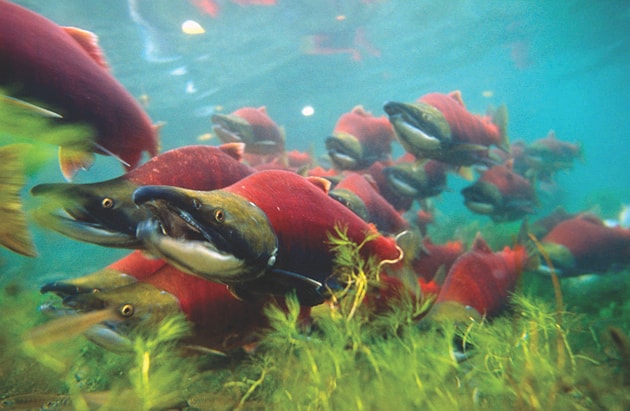A decade ago, the idea of a commercial or recreational sockeye salmon fishery in the Okanagan was unheard of.
Thanks to the efforts of an Okanagan Nation Alliance program to restore the salmon run, those fisheries have been a reality in the last few years and have even begun developing into an economic driver for local communities and First Nations bands.
This year, however, the fisheries won’t be happening. Temperatures in rivers and streams have started to drop, but the 2015 sockeye run is unlikely to set any records.
Howie Wright, a biologist with the Okanagan Nation Alliance fisheries department, said that in normal years, they would expect to see about 75 per cent of the sockeye coming over Bonneville Dam making it to Wells Dam, the last barrier for sockeye before entering the Okanagan River.
“About 50 per cent of the Okanagan Sockeye that went over Bonneville, went over Wells Dam,” said Wright. High temperatures in the streams and lakes were a major problem, with about a third of the later part of the run were delayed below McNary Dam, where the Snake comes into the Columbia River.
“The thermal barrier set up in the Okanagan River much earlier,” he said. “Back in early July, the temperatures were probably about 8 degrees higher. When it would normally be 16 degrees Celsius, temperatures were already 24 C.”
Earlier this month, there were an estimated 10-15,000 in Osoyoos Lake, far removed from last year’s estimate of 200-250,000 at the same time.
Warm waters aren’t the only hazard the returning sockeye face. Last week, 14 empty containers of boat engine oil were spotted floating at the dam in Okanagan Falls. Experts said that though lingering residue could cause problems. A few drops might not cause toxicity in the fish, but the scent of oil in the water could also deter sockeye from continuing their journey upriver.
Wright isn’t sure the sockeye remaining below McNary Dam will continue their migration even when the water cools, noting that local fisheries workers are already seeing mortalities among the salmon and other species.
“I think they documented about 80 dead sturgeon,” said Wright.
Wright said the estimate is between 30-60,000 salmon will make it to the spawning beds in the Okanagan. this year.
“We are expecting that if there is about 190,000 that went over Wells Dam that probably it will be in the 30 to 50 per cent range. That’s where I think we estimated it will be in the 30 to 60 thousand on the spawning grounds.
“Our spawning escapement is 60,000 on the spawning grounds, but there is capacity for it to take twice that amount,” said Wright. Because of low returns, officials in both B.C. and Washington have shut down fisheries to maximise the amount of sockeye making it through.
“In four years, we will expect a lower return,” said Wright.
